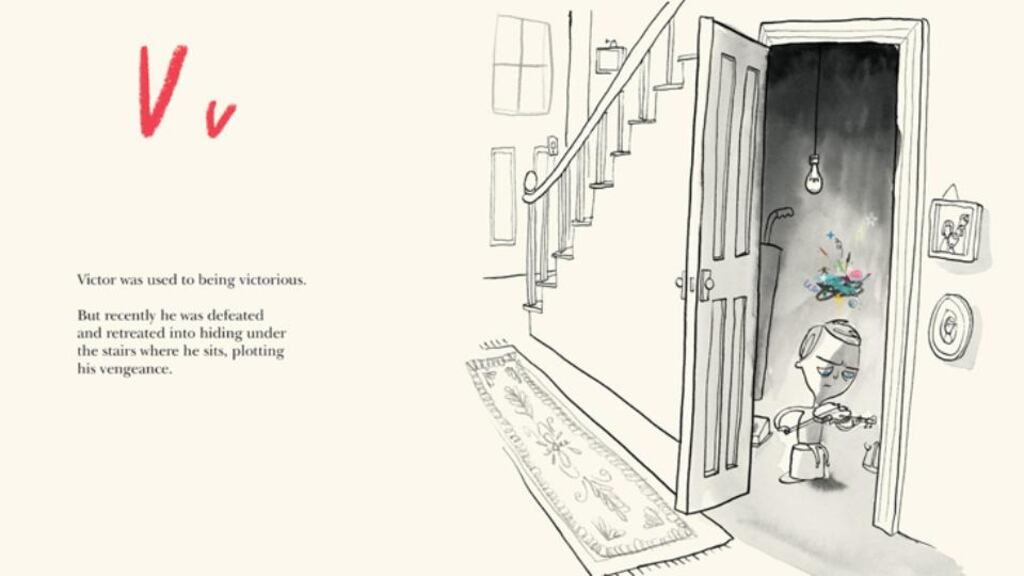In their long and colourful history, alphabet books have evolved from basic instruction manuals to sophisticated and ingenious works of art. With the arrival of Oliver Jeffers’s Once Upon An Alphabet (HarperCollins, £20) this sophistication and ingenuity reach new heights as Jeffers takes our 26 letters and devises for each of them a short story, invariably quirky, frequently surreal and occasionally enigmatic.
The result is a book that, in both verbal dexterity and visual mischief, will impress readers (of all ages) by its wit and originality. Who knew, for example, that the letter Y would serve as take-off for a tale of a yeti, a yo-yo and a yak? A delight from beginning to end, enhanced by high production values and eye-catching design.
Jeffers’s decision to use R as the opportunity for a brief visit to the world of robots serves as a convenient link to Chris Judge’s imaginatively conceived and engagingly executed Tin (Andersen Press, £11.99).
Here is a futuristic robotic environment, beautifully detailed in Judge’s highly coloured pictures, which becomes the background for the diverting story of big brother Tin, little sister Nickel and robot dog Zinc.
When Tin, not the most conscientious of baby minders, finds himself chasing after the wandering Nickel and her fly-away balloon, we have an exuberant narrative of unexpected encounters and sky-high adventures. Robots though they may be, the “characters” remain reassuringly human in their body language and facial expressions.
The prose of Philip Reeve and the cartoon-style graphics of Sarah McIntyre combine in Cakes in Space (Oxford University Press, £8.99) to provide the reader with an irresistibly madcap experience.
Ten-year-old Astra and her family are on their way to a new home on Nova Mundi when their spaceship – crewed by robots – comes under attack; will she, assisted by “a small, roundish sort of robot” known as Pilbeam, be able to avert disaster? What of the alien Poglites of Quarl and their obsession with spoons? What of the creature known as the Nameless Horror? Above all, what of the ferociously cannibalistic legions of voracious cakes? Out of such zaniness comes a great deal of very innocent fun.
Zaniness and innocent fun are significant elements also of what must easily qualify as one of the most beautifully produced children’s novels of the year, AF Harrold’s The Imaginary (Bloomsbury, £12.99), illustrated to magical effect by Emily Gravett.
Here, though, the zaniness and fun take their place within a narrative that poignantly explores the nature of childhood imaginations and the way they can fade as adulthood encroaches.
The relationship between the novel’s heroine, Amanda, and her imaginary friend Rudger serves as starting point for a sequence of escapades, some of them quite chilling, dominated by their confrontations with the fearsome Mr Bunting, reputed to have an appetite that, literally, swallows all “imaginaries”. Who wins, who loses, when reality and nonreality contend?
The chilling episodes that abound in Peter Sirr’s Black Wreath (O’Brien Press, €7.99) are the chills of history rather than those of fantasy. Set in the Dublin and Pennsylvania of the early 18th century, this is the story of a 13-year-old member of an aristocratic family who is dispossessed of the title and property that should rightfully be his.
Forced initially into surviving amid the degrading poverty and omnipresent violence of Dublin, he is subsequently sold into slavery in America. Here even more painful maltreatment awaits him – but also the eventual possibility of returning to his native city.
With some of its details apparently based on real events, Sirr’s novel is rich in its evocation of time and place and strong in its characterisation. Its world has its cruelties, but goodness and loyalty have their place also.
That hope may grow in even the murkiest corners is suggested also in Cate Sampson’s Splintered Light (Simon & Schuster, £7.99), a thriller aimed primarily at a young-adult readership. This is an intricate, ingenious novel, bringing together the stories of three British teenagers when they are sucked into the unsavoury world of adult criminality.
Their interweaving experiences, convincingly linked by Sampson, reveal aspects of contemporary life that are ugly and violent but through which it is necessary to pass if the future is to be faced with any degree of optimism. The novel’s strength lies not just in its compelling narrative but also in its encouraging the reader to consider such matters as the nature of innocence, guilt, revenge and retribution.
It also serves as a reminder of the manner in which the unfinished business of the past can haunt present-day lives.
Every so often a book appears that, although ostensibly intended for children, will appeal to book lovers of all ages. John Agard’s Book (Walker Books, £12.99), tracing the book’s evolution from clay tablet to its contemporary electronic manifestations, is a fascinating example of a genuinely crossover volume.
Written in the first person, as if by the “book” itself, it addresses its readers directly, conducting us on a tour that embraces matters of, among much else, historical, literary, sociological and technological interest. These are entertainingly peppered with amusing anecdotes and esoteric information: why, for example, is a “blurb” called a blurb?
The tone throughout is conversational, light-hearted and enthusiastic, without ever becoming didactic. Neil Packer’s playful illustrations are totally in tune with the text.












